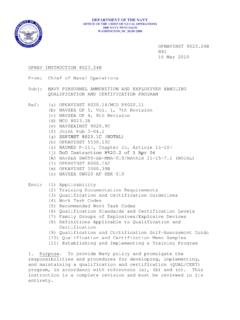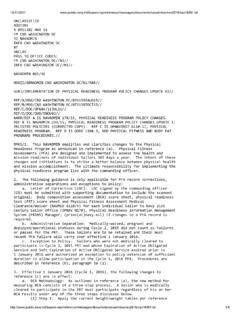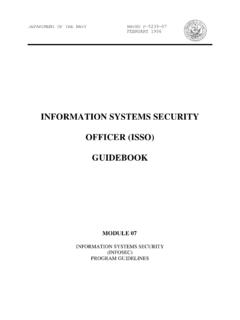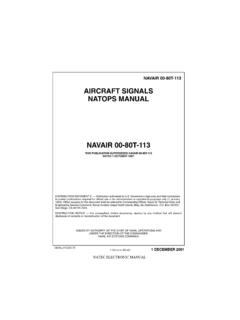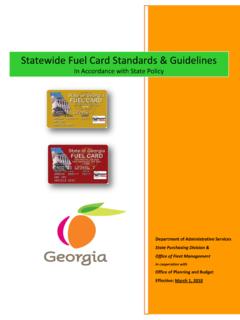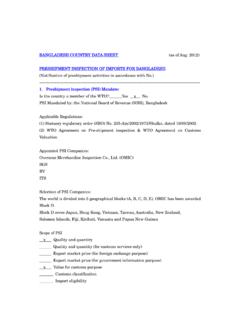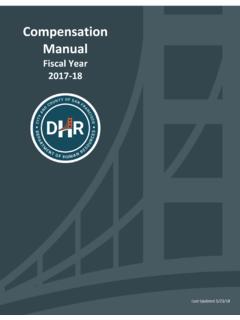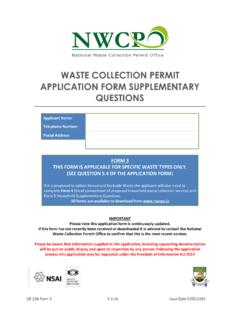Transcription of DISTRIBUTION «ÜTOTEWIENT A 032 fcH-'b! …
1 DEPARTMENT OF THE NAVY NAVAL AIR SYSTEMS COMMAND NAVAL AIR SYSTEMS COMMAND HEADQUARTERS 47123 BUSE ROAD. UNIT II -rprp iN REPi-V REFER TO PATUXENT RIVER. MD 20670-1S47 NAVAIRINST FEB 25 1999 NAVAIR INSTRUCTION From: Commander, Naval Air Systems Command Subj: PROCEDURES FOR SUBMITTING FLIGHT LOADS, LAUNCH, AND LANDING DATA FOR THE STRUCTURAL APPRAISAL OF FATIGUE EFFECTS PROGRAM Ref: (a) Navy Management Systems Support Office Document J-004 EM-001, End User's Manual for the Naval Aviation Logistics Command Management Information System for Organizational Maintenance Activities (b) Naval Aviation Depot Cherry Point Letter Serial Number 35320-JM, Implementation of Maintenance Requirement Cards for the Counting Accelerometer Group (c) Naval Air Systems Command Report Control Symbol 13920-T/M/S, Structural Appraisal of Fatigue Effects Report Series Encl.
2 (1) Listing of Abbreviations and Acronyms (2) Listing of Navy Flight Loads Data Recorders (3) Listing of Commercial, Off-The-Shelf Aircraft and Their Reporting Requirements (4) Instructions for Preparing and Submitting Flight Loads, Launch, and Landing Records Using NALCOMIS OMA and SALTS (5) Instructions for Preparing and Submitting NAVAIR 13920/1 (Rev. 8/98), Flight Loads/Launch/Landing Data 1. Purpose. To establish the policy and procedures needed to prepare and submit flight and ground loads data for all Navy fixed-wing and rotary-wing Type/Model/Series (T/M/S) aircraft. 2. Cancellation. This instruction supersedes Naval Air Systems Command (NAVAIR) Instruction of 20 October 1997. Because this is a major revision, changes have not been indicated.
3 3. Scope. This instruction applies to all active Naval Aircraft Reporting Custodians (Naval Aviation Depots (NAVAVNDEPOTs), Naval Air Warfare Centers (NAVAIRWARCENs), Type Commanders (TYCOMs), and Fleet Support Teams (FSTs)). 4. Discussion. The Navy has established a fleet-wide flight loads monitoring program using Flight Loads Data Recorders (FLDRs) and other related flight usage information. Enclosure (1) DISTRIBUTION TOTEWIENT A ----MM** *mt\ Approved fcH-'b!;(s)^!8a^08_LD_024_0480 20001129 032 ^ ,l ^i ^ . NAVAIRINST 25 Feb 99 lists common abbreviations and acronyms. Enclosure (2) lists the FLDRs used on each of the Navy's fixed-wing and rotary-wing aircraft. The data obtained from this program provide the Structural Appraisal of Fatigue Effects (SAFE) program with the information necessary for: a.
4 Determining maximum individual aircraft and/or dynamic component retirement time while maintaining safety margins; b. determining time for rotation out of severe service usage to optimize aircraft utilization over its service life; c. identifying and monitoring individual aircraft accumulating severe or excessive load occurrences and aircraft with unusually high fatigue damage accumulation rates; d. recognizing changes in service usage trends; e. projecting aviation inventory levels that motivate test and modification/improvement plans and influence acquisition strategy; f. providing information affecting depot level maintenance schedules, Aircraft Service Periods Adjustments, in-service structural inspection intervals, and modification inductions; and g.
5 Establishing design requirements for future naval aircraft. 5. Policy a. This instruction is applicable to all Navy owned and/or operated aircraft (fixed-wing and rotary-wing). Enclosure (3) lists exceptions to the reporting requirements of this instruction for certain commercial, off-the-shelf aircraft, as specified in writing by the program manager. b. Frequency and procedures for submitting monthly reports, conditional reports, and FLDR data are detailed in paragraph 6 and enclosures (4) and (5) of this instruction. 6. Action. Naval Aviation Logistics Command Management Information System for Organizational Maintenance Activities (NALCOMIS OMA) (version or higher) and the Streamlined Automated Logistics Transmission System (SALTS) (version or higher) are the preferred means for reporting flight loads, launch, and landing data.
6 Reporting custodians shall utilize NALCOMIS OMA and SALTS as their means to submit data whenever available. Reporting custodians shall utilize NAVAIR 13920/1 (Rev 8/98), Flight Loads/Launch/Landing Data, only when NALCOMIS OMA and SALTS are unavailable. NOTE: Reporting custodians may have to perform several reporting actions each month ( , complete and submit monthly data, complete and submit any FLDR removal reports, and download and submit FLDR data). NAVAIRINST 25 Feb 99 a. Reporting custodians utilizing NALCOMIS OMA and SALTS shall submit Flight Loads, Launch, and Landing Records (FLLLR) as detailed in reference (a) and enclosure (4) by (1) the fifth day following the end of each month for each aircraft under their cognizance; and (2) the fifth day following any FLDR removal, installation, strain gage calibration, or strain gage change.
7 B. Reporting custodians not utilizing NALCOMIS OMA and SALTS shall, for each aircraft under their cognizance, complete NAVAIR 13920/1 as detailed in enclosure (5) by (1) the fifth day following the end of each month for each aircraft under their cognizance; and (2) the fifth day following any FLDR removal, installation, strain gage calibration, or strain gage change. c. Reporting custodians with fixed-wing aircraft equipped with Counting Accelerometer Groups (CAGs) shall check for the malfunction conditions as detailed in local instructions for each indicator reading and take corrective action as required. Reporting custodians shall submit results of any testing performed on a CAG in the remarks section of either NAVAIR 13920/1 (Rev. 8/98) or the Aircraft Readings display when using NALCOMIS OMA.
8 D. Reporting custodians with aircraft equipped with multiple parameter FLDRs shall download the FLDR and submit the data following local instructions. Submit all S^-inch disks or 9-track tape reels to the Aircraft Structural Life Surveillance Branch ( ) at the address in paragraph 7. e. Depots shall comply with paragraph 6a through 6d, as applicable, for all aircraft upon induction into rework (commercial or government depot). All FLDR data collected during a depot rework cycle, including all check flights, shall be downloaded and submitted following local instructions. Submit all 3!/2-inch disks or 9-track tape reels to f. FSTs shall: (1) ensure that FLDRs are properly functioning while installed on an aircraft; (2) update the Maintenance Requirement Cards (MRC) for aircraft equipped with the Systron-Donner CAG to provide for routine test and check using the AN/ASM-688 CAG test set.
9 Refer to reference (b) for additional information and guidelines for establishing intervals; and NAVAIRINST 25 Feb 99 (3) coordinate with the Depot Maintenance Interservice Support Agreement (DMISA) manager to incorporate reporting requirements into the DMISA (exhibit VII-A or XVII) and DMISA reports (exhibit X) and negotiate the new reporting requirements with the DMISA agent. g. shall provide summaries to the TYCOMs confirming data receipt with FLDR functional status for every aircraft. Letters or messages shall be provided every quarter for aircraft equipped with CAGs and every month for aircraft equipped with multiple parameter FLDRs. Aircraft fatigue and usage information shall be promulgated through reference (c). h. TYCOMs shall ensure that reporting custodians take corrective action to identify then repair or replace malfunctioning FLDRs.
10 I. Program Managers shall ensure that commercial contractors under their cognizance that perform depot-level rework comply with the subparagraph 6a through 6d instructions listed for government depot-level rework facilities. 7. Change Recommendations. solicits useful comments and recommendations for changes to the procedures and form contained in this instruction. Please forward ideas for changes to the following: AIRCRAFT STRUCTURAL LIFE SURVEILLANCE BRANCH ATTN: BLDG 2187 SUITE 2320A NAVAL AIR SYSTEMS COMMAND 48110 SHAW ROAD UNIT 5 PATUXENT RIVER, MD 20670-1906 Phone: Commercial (301) 342-9323 (DSN 342-9323) FAX: Commercial (301) 342-9406 (DSN 342-9406) 8. Forms. NAVAIR 13920/1 (Rev. 8/98), Flight Loads/Launch/ Landing Data, S/N 0102-LF- 994-2300, shall be ordered per CDROM NAVSUP Pub 600 (NLL).
